Sections
Introduction
The main objective of the P2 experiment is the determination of the weak mixing angle sin²θW from the measurement of the parity violating (PV) asymmetry in the elastic electron proton scattering, with an accuracy comparable to that of the existing collider measurements of Δsin²Θw=0.0003 (0.13% relative uncertainty). The low momentum transfer of Q²=0.005 (GeV/c)² makes the P2 project complementary compared to past and upcoming high energy experiments. The weak mixing angle is a key parameter of the Standard Model that relates the couplings of W and Z bosons to leptons and quarks. Its precise determination allows to test the Standard Model and either will help to exclude Standard Model extensions or to identify the type of physics beyond the Standard Model.
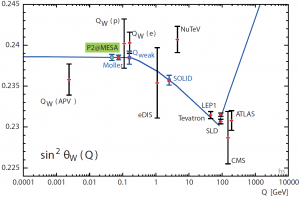
The expected size of the parity violating asymmetry is APV≈30 ppb (parts per billion), the P2 experiment aims for a total uncertainty of ΔAPV≈0.5 ppb which places high demands both on the accelerator concerning beam stability and on the experiment concerning statistics , background separation, momentum transfer determination and polarization measurement. Theory support is necessary in order to treat radiative corrections with the needed accuracy and later in order to interprete the measured asymmetry in terms of new physics beyond the Standard Model. A 60 cm long liquid hydrogen target together with a beam current of 150 µA will provide a luminosity of L≈2.4·1039s-1cm-2. A solenoid spectrometer with fused silica detectors will be setup for the detection of the scattered electrons and the separation of background events. A tracking system based on High Voltage Monolithic Active Pixel sensors (HV-MAPS) will be installed in order to determine the momentum transfer Q² with high precision. Two types of electron polarimeters are under development, a so-called Hydro Møller polarimeter and a Double Scattering Mott (DSM) polarimeter, the goal is a determination of the degree of polarization of the electron beam with an accuracy of ΔP/P=0.5% .
P2 Solenoid spectrometer
The detection of the elastically scattered electrons and the separation of background events will be accomplished by an integrating magnetic spectrometer/detector apparatus. We are investigating both the design of the spectrometer regarding magnetic field configuration and placement of shielding and the properties of the fused silica Cherenkov detectors.
Spectrometer design
In principle two designs of the magnetic field are possible: A toroidal or a solenoidal magnetic field. A solenoidal field would have the advantage that the detector could cover the whole azimuthal angle. This would lead to a larger covered solid angle and a reduced measurement time for achieving the same statistical precision. Both solutions were studied extensively by means of full GEANT4 Monte Carlo simulations.
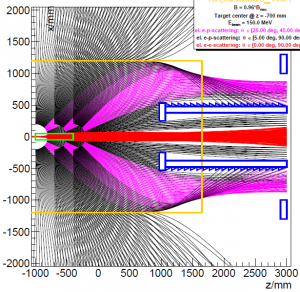
First, electrons with a beam energy of 150 MeV are shot into a target volume of liquid hydrogen with a length of 60 cm and a diameter of 5 cm. From the interaction of the electrons with the hydrogen we get a vertex distribution in the target. From this distribution which includes information about the position in the target and the electron four-momentum, the elastic scattering events are generated. So far, these events are generated using the simple Rosenbluth formula. All other events are generated with the built-in GEANT4 algorithms. The generated particles are then tracked through the magnetic field. Secondary processes like scattering off a lead shield are taken into account. Virtual detectors are installed at judicious locations and lead shield geometries were iteratively optimized to maximize background suppression.
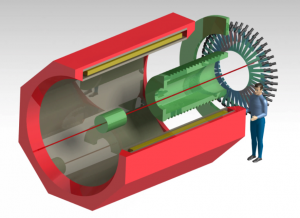
Integrating detectors
The scattered electrons will be detected by Cherenkov detectors which have the advantage to be insensitive to neutral background. Since we expect extremely high rates in the order of 10 million electrons per mm², the detector material must be radiation hard. Cherenkov radiation is emitted mostly in the ultraviolet region, so transmission within the detector material into the deep UV region is desirable. Fused silica (“quartz”) bars satisfy these requirements. A single detector module will consist of the quartz bar wrapped in a reflecting material in order to reduce reflection losses at the surface, maybe an air light guide made of a reflecting material and then a photomultiplier tube. For the full detector we expect that a few hundred modules are needed. All components of the detector modules need to be optimized for transmission, reflection and detection of photons in the deep UV range.
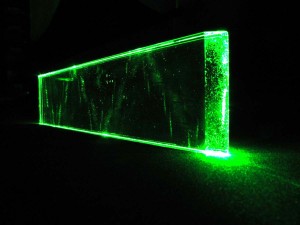
Great effort has been applied to study the fused silica bars, especially the impact of geometry and surface properties on the photon yield. Beam tests were done at the MAMI accelerator. In parallel to the beam tests, a MC simulation was developed for the production and propagation of Cherenkov light within the quartz bar. In combination with the PMT quantum efficiencies, one can obtain from this simulation the detector response which is needed for the optimization of the final spectrometer setup.

Tracking detector
The P2 project will require tracking detectors for three different purposes:
- Inside the spectrometer solenoid for a determination of the average squared momentum transfer <Q²>
- At backward angles for an improved determination of the strange magnetic form factor
- For the polarization measurement with the Hydro Møller polarimeter
For all three purposes one needs detectors witg as little material as possible. The advent of well-in-well integrated circuit manufacturing technologies has allowed for the development of monolithic sensors incorporating both depletion voltage (allowing for fast charge collection via drift) and on-sensor amplifier and readout electronics: The High Voltage Monolithic Active Pixel Sensors (HV-MAPS).

The tracking detector geometry and placement affect the achievable resolution, back- ground levels, ease of track reconstruction, mechanical realisation, ease of cooling and total area and is consequently the first issue to be decided. The central scattering angle of θ = 35◦ with regard to the solenoid field axis suggests a disk geometry (see picture below) due to the lower amount of material seen by the tracks at equal layer thickness, the larger achievable lever arm and the larger distance to the target which reduces background from bremsstrahlung photons.

Theory
A reliable interpretation of the measurement of parity violating asymmetry as a precision determination of the weak mixing angle will require a correspondingly trustworthy understanding of theory predictions.This includes the calculation of higher-order perturbative corrections and a thorough analysis of uncertainties caused by uncalculable hadronic form factor input.
QED corrections
QED corrections have to be known with high precision since any emission of unobserved photons may lead to a shift of the measured momentum transfer, and a Monte Carlo approach will be required for the reconstruction of the kinematics of the scattering process. Based on previous work we shall investigate the missing ingredients required for the development of a full Monte Carlo simulation program including O(α²) radiative effects.
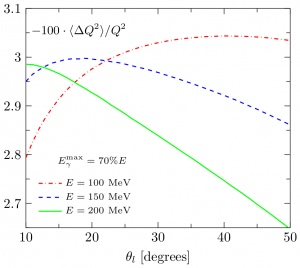
transfer Q² due to bremsstrahlung assuming that scattered electrons with energies above 30 % of
the beam energy contribute to the event rate.
Two-loop electroweak corrections
Two-loop electroweak corrections will modify the relation between the measured parity violating asymmetry in polarized electron proton scattering and the weak mixing angle. Preliminary results for the related process of Møller scattering have shown that these corrections may be larger than naively expected by counting powers of α and they will have to be calculated as well. There is a large number of diagrams to be evaluated, but techniques are known and the challenge is mainly one of organization and book-keeping of a large number of contributions. Analytical calculations will be needed to separate purely weak from photonic corrections. This requires a proper regularization of infrared and collinear divergences.
Search for new physics
Apart from the interpretation of the experimental data for the polarization asymmetry in terms of the weak mixing angle, we also plan to perform analyses with the aim to put limits on extensions of the Standard Model, for example in terms of the effective quark coupling constants C1u and C1d or within specific models like supersymmetry or models with a dark photon. Support from theory will be needed for this kind of analysis of the expected data.
Box graph and hadronic uncertainties
All previous calculations of the γZ box graph contributions which were applied to the Qweak experiment have been done in the exact forward direction. For the P2 experiment, a re-evaluation at non-zero scattering angles will be required. We have started a project which aims at such a calculation, using a dispersion relation framework and taking into account πN intermediate states. Moreover, the previous calculations refer to the box graph correction related to a hadronic vector current. There is an additional contribution from hadronic axial-vector currents which is expected to be sub-dominant, but its calculation is also required in view of the high precision aimed for in the proposed experiment. Hadronic contributions to γ − Z propagator mixing, in perturbation theory described by the insertion of quark loops, affect the running of the weak mixing angle. Invoking isospin symmetry, this one-loop contribution can be related to the photon vacuum polarization and is then obtained to a good precision from e+ e− data by using a dispersion relation.
Polarimetry
Within in the P2 project the polarization of the electron beam must be determined with an uncertainty of 0.5% or even less. For this purpose two polarimeters are foreseen which both offer high absolute accuracy.
Double Scattering Mott Polarimeter
The Double Scattering Mott Polarimeter (DSP) operates at a beam energy of 100 keV, which is a suitable injection energy for MESA. This device is invasive. Double elastic scattering allows us to calibrate the effective analyzing power of a polarimeter with an accuracy below 0.5%. This was demonstrated at the university of Münster in the early 1990’s. We have obtained the original Münster apparatus and will adapt it for the needs of our experiment. This includes a series of systematic cross checks which are needed to ensure the validity of the assumptions for double elastic scattering. The Munster apparatus was installed at a 100 keV source which can be regarded as a template for the source of the MESA accelerator. It is now equipped with new gold-foil-targets on Formvar backing, which were provided by the target laboratory of GSI in Darmstadt. The detector electronics, the data acquisition and large parts of the vacuum system were refurbished. The beam line connecting the source and the DSP was equipped with a series of improved beam diagnostic devices which allow stable and reproducible beam alignment.
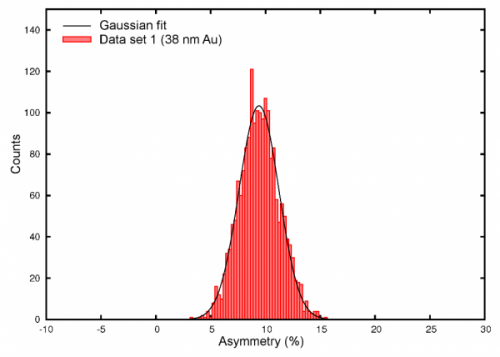
Hydro-Møller-Polarimeter
We are investigating a new type of Møller polarimeter based on a polarized atomic hydrogen target (’Hydro-Møller-Polarimeter’). This device could be operated online (i.e. it can be considered as ’non-invasive’) and at the energy of the experiment. The concept is based on the fact that atomic hydrogen can be trapped by the combination of a longitudinal (axial) magnetic field of a solenoid and a cryogenic radial enclosure. Typical target parameters are a target length of 0.20 m, and a target density of ρH = 3.0 × 1015 cm−3 . On the one hand this density is large enough to allow relatively fast measurements during the P2 experiment. On the other hand it is low enough not to disturb the beam significantly. Therefore the device is suitable for online operation. The main feature for polarimeter operation is that the target electrons are almost entirely polarized. This eliminates the main systematic error of a conventional Møller polarimeter, since the target polarization would be known to be > 99.9% with an error of less than 0.1%. This holds for fields of B ≥ 8.0 T which also leads to axial trapping of the polarized hydrogen due to Stern-Gerlach forces in the fringe of the solenoid. Radial trapping is obtained by suppressing the wall recombination/attachment processes by
a superfluid helium surface film held at a temperature of Twall = 0.25 − 0.30 K. The heat load in the system is considerable and can only be handled by a suitable 3He / 4He mixing cryostat.
